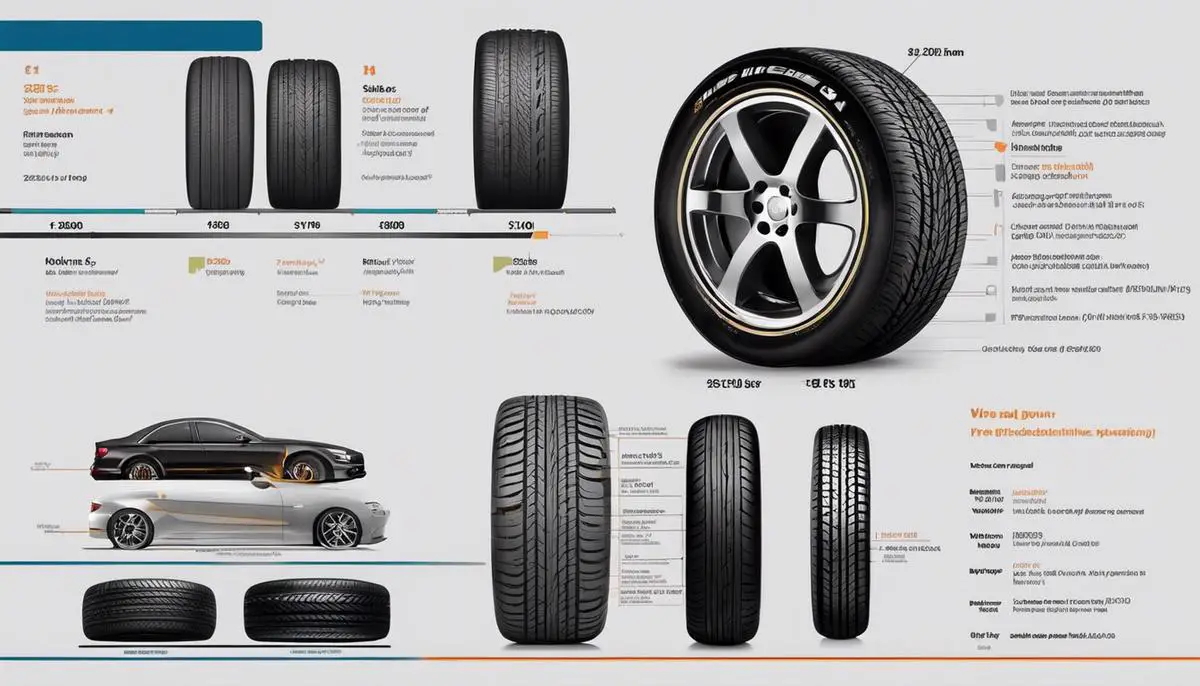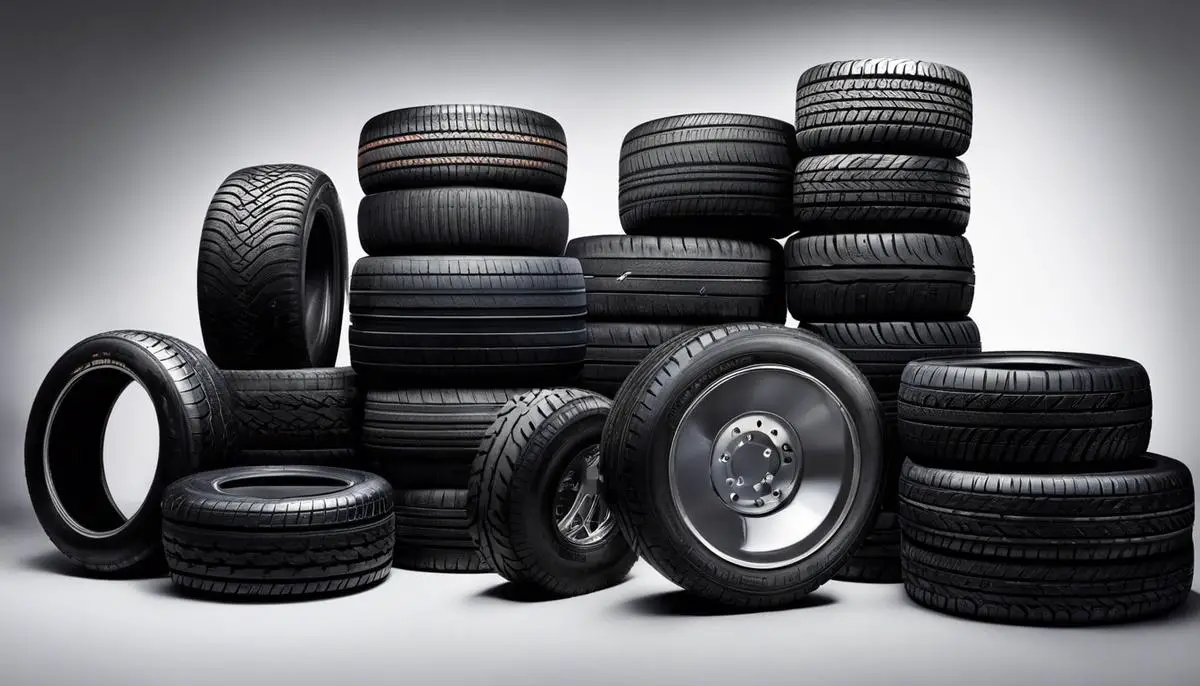For many drivers, the choice of tires for their vehicle is often influenced by factors such as price, brand reputation, and tread life. However, there is more to selecting a tire than just these considerations. Understanding how different tire specifications can affect road handling is critical, as it impacts not just the performance and efficiency of your vehicle, but your safety on the road as well. This discussion shines a spotlight on relevant aspects such as tire sizes, materials used in tire manufacturing, the role of tread patterns, and the effects of tire pressure on vehicle control.
Contents
Tire Sizes and Their Impact on Handling
Unraveling The Mystery: Understanding Tire Size Impact On Road Holding Capabilities
Few things are more exhilarating than hitting the open road – feeling your vehicle hug the surface as you navigate turns, even at high speeds. The key to this pleasure ride? Well, a much understated mystique: the tire. It might seem relatively straightforward, but there’s more to these rings of rubber than meets the eye, especially when it comes to their size. Let’s explore how tire size can influence a vehicle’s grip on the road.
To kick things off, you need to know that a tire’s size is crucial to its overall performance and road holding capability. The tire size is essentially a match-up of three important figures – the width, the aspect ratio, and the wheel diameter. Didn’t realize there’s a mathematical side to this, did you?
The tire width is the first number you’ll see on a tire’s sidewall. This measurement, in millimeters, refers to the tire’s tread width. Larger figures indicate a wider tire. Logically, a wider tire comes with a bigger footprint, providing a larger surface area in contact with the road. This increases traction and, in turn, stability and handling prowess – features integral for avoiding those skin-of-the-teeth moments on sharp turns or wet surfaces.
Meanwhile, the aspect ratio represents the tire’s profile – the height of the tire’s sidewall compared to its width. For example, a tire with an aspect ratio of 60 means the height is 60% of its width. Lower aspect ratios (short sidewalls) are typically found in performance vehicles. These tires are often better at speeding around curves, offering more road-holding and less rolling resistance. They’re the co-conspirators behind that exhilarating, stable ride feeling.
Lastly, the wheel diameter – the final number in the tire size definition – corresponds to the wheel’s size in inches. It’s the size of the tire from one end to the other. Again, larger wheels often mean better grip but at the cost of a less comfortable ride, as they reduce the tire’s ability to absorb bumps.
It’s important to remember though, a larger tire might increase gripping prowess, but it’s not without drawbacks. Bigger tires can be heavier, reducing acceleration and fuel efficiency. They could also mess with your speedometer readings if not calibrated correctly. Not to mention, they can sometimes require modifications to your vehicle to fit properly – extra cost and effort.
And we must not overlook the type of tire used. Even size can’t rescue a poor-quality tire. High-quality rubber compounds, tread designs, and other tire technologies also play a significant role in defining road-holding capabilities.
So there you have it. How you size up your tires can genuinely impact ride quality. Take the time to understand what size works best for your specific vehicle and driving conditions to get the most out of your rides. Choosing the right size and type of tire might seem complex, but, trust us, that sweet, smooth ride will be worth all the calculations!

Tire Materials and Road Interaction
Shifting gears from our discussion about tire sizes, let’s now navigate into how the material of your tire can significantly influence your overall road handling experience.
Primarily manufactured from rubber, tires are far from homogenous. They are integrated with a complex blend of materials, each contributing distinct characteristics to the tire’s overall grip, durability, and performance. This combination makes the tire a vital component impacting road handling. Two primary materials used are synthetic rubber and carbon black.
Take synthetic rubber, for instance. It serves as the foundation of the tire, providing essential attributes like pliability and resilience. Even at extremely low temperatures, synthetic rubber remains flexible, allowing tires to maintain grip and continue providing traction. The tire’s flexibility also boosts its durability, countering the constant wear and tear as the rubber deforms and reforms due to road irregularities.
Now, think of carbon black. This material is mixed with the rubber during the production process, enhancing the overall strength and durability of the tire. It considerably boosts heat dispersion, a key factor underpinning tire’s longevity. Moreover, carbon black increases road adhesion, enhancing grip and therefore, road handling.
In desirable synergy, the binding of these two materials also promotes reduced rolling resistance. This effectively boosts fuel efficiency of vehicles without impacting the tire’s grip on the road.
Let’s also not forget about silica. A relative newcomer to tire material composition, silica reduces rolling resistance further, alongside contributing to improved wet traction. Blend this with the right amount of rubber and carbon black, and you’ve got a tire ready to meet the demands of varied weather or wet road conditions.
Dig a little deeper, and you’d notice that certain high-performance tires also incorporate materials like Kevlar. Known for its incredible strength-to-weight ratio, the use of Kevlar in tire manufacturing ultimately results in lighter but sturdier tires, providing exceptional handling and speed capabilities.
Each layer of material within a tire has a specific role that caters to safety, handling, comfort and performance. From the interior lining ensuring your tire remains inflated, the plies providing rigidity, to the bead binding the tire to the wheel, each contributes to road handling in a significant way.
It is insightful to remember that a tire’s material composition isn’t a one-size-fits-all scenario. Different driving styles, climate conditions, and road types demand different tire compositions for optimal performance. What might work exceptionally well on smooth city roads might not be ideal for off-road tracks or snowy conditions.
Next time you find yourself wondering about the perfect tires for your vehicle, cast a glance beyond just the size. Taking into account the material composition and the unique blend of performance properties it offers could well steer you towards a smoother road handling experience.

Tire Tread Patterns and their Effect on Grip
Unmasking the Role of Tire Tread Patterns in Vehicle Control: The Untold Story
After exploring the immense influence of a tire’s size and composition on vehicle performance, let’s dive headlong into another critical facet of tire design that impacts control – the tire’s tread pattern. Far from random arrangements of grooves and blocks, tire tread patterns are meticulously engineered to maximize road grip, manage traction, and improve ride stability in a wide range of conditions.
At its core, the tread pattern is responsible for optimizing the contact of the tire with the road surface. Its primary purpose is to allow water to move away from the tire, minimizing hydroplaning and improving grip on wet roads. That’s why keen attention to tread patterns becomes particularly crucial when driving in bad weather. Simply put, think of tread patterns as your own customized rain boots – in car shoes!
There are three basic types of commonly used tread patterns, each with its unique characteristics: symmetrical, asymmetrical, and directional (or unidirectional). To navigate this labyrinth of patterns, let’s demystify each.
Symmetrical tread patterns, as the name suggests, feature the same design on the inner and outer halves. The equal distribution of pattern amounts to uniform wear, enhancing tire lifespan as well as noise reduction. They’re a common choice for passenger vehicles due to their versatility and cost-effectiveness.
Asymmetrical tread patterns sport different tread designs across the tire’s surface. This imbalance is deliberate–to balance the complexities of dry and wet weather handling and provide all-round performance. The inner part usually contains more grooves to tackle water dispersal in wet conditions, while the outer part, sporting solid tread blocks, offers superior dry grip and sharper handling.
Finally, the directional tread pattern tires, identifiable by their ‘V’ shape design, are optimized for water displacement and preventing hydroplaning at higher speeds. These are the daredevils of the tire world, gaining popularity with performance and sports vehicle enthusiasts.
Beyond these common patterns, techniques like ‘siping’ introduce thin slits in the tire’s surface, providing additional biting edges for superior traction on icy or snowy roads. Manufacturers continually experiment with these patterns to strike the elusive balance between performance, safety, noise, and longevity.
Moreover, tread depth plays a vital role in overall tire performance, with deeper grooves enabling better water displacement, but possibly at the cost of road noise and tire stability at higher speeds.
Just as in any hobby, the deeper you delve into the world of tires, the more fascinating the minute details become. Remember, no single ‘best’ tread pattern fits all driving conditions. It’s important to consider individual driving habits, local climate, and road conditions when picking the perfect tread pattern for your vehicle. It’s not simply about fancy designs or technological kevababble – it’s about getting the best performance and most importantly, ensuring the greatest safety for all road users.
So, next time you drive, don’t just tread lightly, instead “read” your tread design wisely!

Tire Pressure’s Impact on Vehicle Control
Now, let’s delve into another crucial aspect of tires that significantly contributes to road handling: tire pressure. In essence, tire pressure is the amount of air in your tire and is usually measured in pounds per square inch (PSI). Maintaining the right amount of tire pressure is not just a matter of safety, but it also significantly influences your vehicle’s grip, performance, and fuel efficiency. Lower tire pressure means more of the tire’s surface area is in contact with the road, which results in better traction. This is especially helpful in tricky road situations like off-roading or navigating snowy or icy roads. However, this advantage comes with a trade-off. More surface area in contact with the road increases friction, which can lead to more tire wear, overheating, and eventually, premature tire failure. In addition, lower tire pressure can decrease fuel efficiency because the vehicle’s engine must work harder to overcome the increased resistance. On the flip side, a tire inflated beyond its recommended pressure will have less surface contact—we call this “over-inflation.” Over-inflation aids in fuel efficiency since it reduces the rolling resistance. However, when the tire’s contact with the road is lessened, the vehicle can become more sensitive to steering inputs and can lead to erratic handling, compromised braking performance, and a harsher ride due to decreased shock absorption.It’s also important to note that tire pressure isn’t a “set it and leave it” kind of deal. It needs to be checked regularly since it naturally decreases over time. For every 10 degrees Fahrenheit change in temperature, tire pressure will change about 1 PSI. Tires can lose 1 to 2 PSI per month due to air leakage from the components of the tire, mostly from the bead area where the tire meets the rim.
Tire pressure should always be checked when the tires are “cold” – that is, when the car has been parked for a few hours or has been driven less than a mile. This is because running tires generate heat, which increases the pressure inside the tire, resulting in a false reading. The recommended tire pressure for your specific vehicle can typically be found in the vehicle’s manual or on a sticker on the driver’s-side door jamb or glove box door.
In conclusion, tire pressure plays a vital, yet often overlooked, role in road handling. It influences traction, fuel efficiency, safety, and comfort. Remember to regularly check and adjust it according to the manufacturer’s specifications and to account for temperature fluctuations and driving conditions. As with tire size, tread pattern, and material, understanding and managing tire pressure is a key element of optimizing your ride.

There is no one-size-fits-all when it comes to choosing the right tire for your vehicle. Various factors such as tire size, construction materials, tread patterns, and pressure levels all play pivotal roles in how your car behaves on the road. Regardless of whether you’re a regular commuter, an off-road enthusiast, or a performance vehicle aficionado, understanding how these tire specifications influence road handling will help you make a well-informed decision next time you’re in the market for new tires. As always, the key is to balance your specific needs, whether that be fuel efficiency, tire longevity, noise reduction, or road performance, with the suitable tire specification. And remember, regular maintenance checks, particularly of your tire pressure, are essential for optimal vehicle control and handling.



